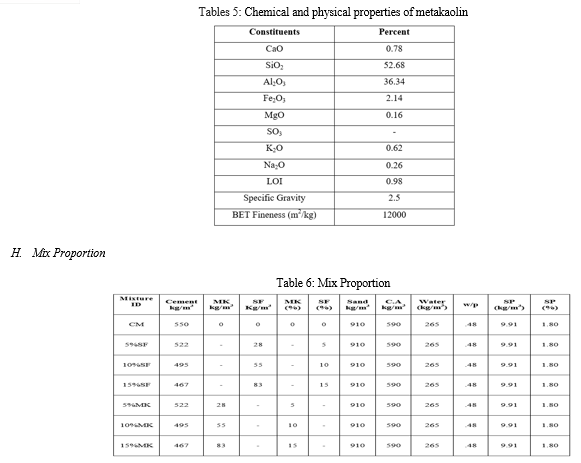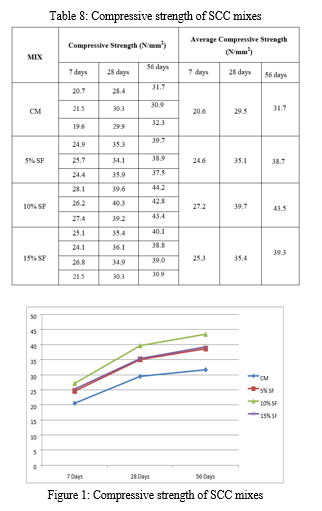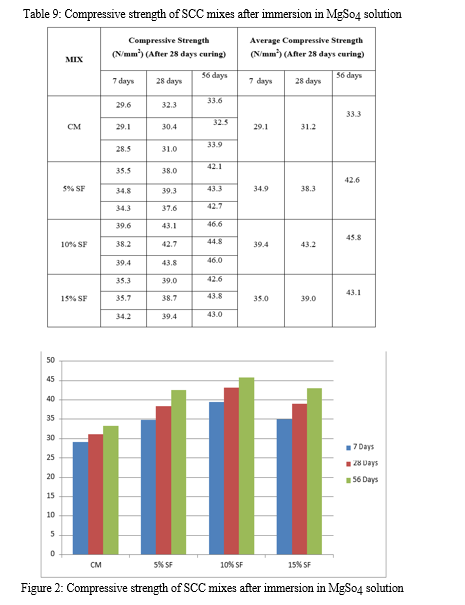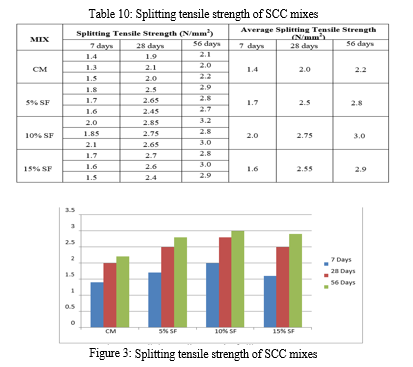Ijraset Journal For Research in Applied Science and Engineering Technology
- Home / Ijraset
- On This Page
- Abstract
- Introduction
- Conclusion
- References
- Copyright
Strength Properties and Sulphate Resistance of Self-Compacting Concrete Incorporating Silica Fume and Metakaolin
Authors: V E S Mahendra Kumar , N. Srikanth
DOI Link: https://doi.org/10.22214/ijraset.2024.59139
Certificate: View Certificate
Abstract
Self-compacting concrete, or SCC, makes it possible to go over obstacles and get rid of vibration. Since 1988, SCC has been more and more well-liked in Japan, Europe, and the US due to the benefits it provides. SCC technology may reduce or perhaps completely eliminate concrete laying issues in difficult situations. Additionally, it reduces the number of times quality control tests need to be performed, saving time and effort. Quicker and less intricate in terms of placement and structure. When vibrating is not utilized, noise pollution is decreased. Concrete becomes more durable when SCC is used, particularly in parts with permeability defects or reinforcing congestion. The goal of this study is to look into how resistant self-compacting concrete made with metakaolin and silica fume is to sulfates and what its compressive and splitting tensile strengths are. Metakaolin and silica fume may also be used as cement substitutes at 5%, 10%, and 15% levels. The tests that are performed on the samples include sulfate, compressive resistance, and cracking tensile strength. On the seventh, 28th, and 56th days of life, a test is given. This experiment using self-compacting concrete from Metakolin and silica fume passed every plastic stage test with flying colors. Furthermore, the splitting tensile strength and hardened-stage compressive strength tests yielded good results. Comparing metakaolin with silica fume, the compressive strength increased by 15–45% and 18–38%, respectively. The use of metakaolin for cement and silica fume in the building process increased SCC\'s resistance to sulfate.
Introduction
I. INTRODUCTION
The construction of concrete buildings has been accomplished without the presence of vibration. The Tremie approach is often used for the placement of subaqueous concrete since it avoids the need for vibration. Even in the absence of vibration, it is feasible to pour bulk and shaft concrete in an effective manner. On the other hand, these specific instances are less resilient and more difficult to standardize than other examples. Self-compacting concrete (SCC) is now being used, and the present use places a focus on performance, reliability, and quality consistency. It's not a revolutionary concept to think of concrete that can really compress under its own weight. The creation of self-compacting concrete initially included the use of a greater quantity of cement paste. Immediately after that, superplasticizers were included in the concrete. It was necessary to implement placement methods that were both highly specialized and well overseen in order to reduce the amount of combination segregation that occurred. According to Okamura et al. (2003), the paste or mortar must be very flexible and keep the coarse aggregate and mortar from coming apart in order for it to be self-compacting. In addition, the paste or mortar must be able to prevent the separation of the two components. The ability of mortars and pastes to self-compact is one of the attributes that people look for most in these products. It is crucial that this be done in order to ensure that the concrete will be allowed to flow through the specific zone where the reinforcing bars are confined. "Homogeneity" is a term that is used in the context of self-consolidating concrete (SCC) to refer to the capacity of the material to maintain its composition in a consistent manner and to prevent segregation throughout the operations of installation and transportation. The homogeneity of SCC is a distinctive feature that is of great significance. Several methods are applied in order to produce self-compacting concrete (SCC) that is resistant to separation and has great flowability. These methods include: This is because self-compacting concrete (SCC) has an internal material structure that is equivalent to that of high-performance concrete. This is because SCC has a significant number of extremely tiny particles, which gives it the ability to compact itself. This is the reason why things transpire in the manner that they do. There are a few of the components that are similar to one another in a lot of really important aspects.
A. Objectives of Study
- Despite the fact that the SCC has been vigorously marketed across the Middle East over the course of the last five years, the majority of local communities have not adopted it with any meaningful momentum. The lack of durability and consolidation in traditionally vibrated normal concrete has led to a rise in the number of people who are becoming aware of self-consolidating concrete (SCC). This has resulted in a large increase in the dissemination of information about SCC. People are reluctant to take advantage of the benefits that SCC has to offer for a variety of reasons, and these excuses may be broken down into several categories.
- When it comes to locally made SCC, there is a lack of quantity in terms of the amount of research or data that has been released.
- In the event that there are any difficulties related to the manufacture of SCC, they are connected to the use of local marginal materials and the extreme weather conditions that are typical in the region.
II. PROPERTIES OF MATERIALS
The features of self-compacting concrete that was made with and without the addition of silica fume and metakaolin, which is an additional cementing agent, are compared over the course of the experiment. This comparison is carried out in order to determine the differences between the two types of concrete.
In order to discriminate between the two forms of concrete, the purpose of this comparison is to discover the distinctions that exist between them. This comparison serves the objective of discovering the differences that exist between the two versions, which is the reason why it was created. A debate on the information that was utilized in this chapter can be found here. You may find it by clicking on this chapter. The debate may be found at this location. This chapter also contains a description of the basic research that was carried out on concrete samples while they were still plastic. The study was carried out on concrete samples. In the course of these tests, tangible examples were being used. Next, a condensed review of the mix design and the curing procedure that was used throughout the operation will be provided. The presentation of the data will follow this. The next part gives a comprehensive overview of the results and describes all of the research that was conducted on the specimens. Additional information is also included.
A. Cement
J.K. cement, grade 43, was used to make cubes and cylinders in all concrete mixes during the duration of this project. There were no visible solid aggregates in the colorless cement. Grayish with a hint of green undertone was the description given to its consistent shade. A variety of tests are conducted and assessed to determine the cement's specific gravity, fineness, compressive strength, and initial and final setting times. The following tables display the trials that were previously addressed.
B. Fine Aggregates
Sand that complied with the 1970 book's Indian Standard Specifications was acquired locally for the project. An apparatus measuring 4.75 millimeters was used to extract the bigger fragments from the sand. A number of other tests, including water absorption, sieve analysis, bulk density, specific density, and fineness modulus, are performed and taken into account. Tables 4.4 and 4.5 provide the results that were achieved. Grading Zone III comprised the fine aggregates.
C. Coarse Aggregates
The International Standard (IS) refers to the material that is still present after a 4.75-size sieve as "coarse aggregate." One such use is coarse aggregate made from crushed stone. The maximum size of the coarse aggregate is established based on the features of the project.
The largest size of the coarse materials used in this experiment was 10 millimeters, and they were easily obtained nearby. The aggregates were cleaned to remove dust and debris, and they were then dried until the surface was dry. This was the process used in this experiment. Every aggregate was inspected in accordance with the instructions given in IS 383-1970. Tables 4.6 and 4.7 provide the results of several experiments conducted on coarse aggregate.
D. Magnasium Sulphate
The ground magnesium sulfate was purchased from Scientific Junction, a Patiala-based business. It had just white in it. A sulfate resistance test was conducted using a 5% concentration solution made by mixing the material with water.
E. Admixture
For this project, an admixture for water reduction called Conplast SP430 was used. This specific blend meets the specifications listed in IS:9103:1979, BS:5075 Part 3, and ASTM-C-494 type 'F'. Conplast SP 430, a widely available additive, is mixed into the concrete during the batching process. Conplast SP430 is not like other superplasticizers because it uses an aqueous solution of lignosulphonates, which is an organic polymer with long side chains. This method greatly improves cement dispersion. Brown in color, Conplast SP430 spreads well on damp surfaces. The product has been thoroughly developed in order to achieve a notable 25% decrease in water content while maintaining the necessary level of workability. At 30 degrees Celsius, the specific gravity falls between 1.22 and 1.225.
F. Silica Fume
Pozzolanic reactions take place in the concrete mixture when silica fume is added. Amorphous silica, which is created when calcium silicates hydrate, combines with calcium hydroxide to form pozzolan, which is a key component. Calcium silicate hydrate, with the chemical formula C-S-H, is the final result of this process (Mindess et al., 2003). The matrix of micro-silica concrete often exhibits a discernible increase in thickness when micro-silica is added to the concrete mixture (St. John, 1998). The tiny particle size of microsilica may be to blame for the denseness effect.
Silica fume is used in concrete applications when a high degree of imperviousness and compressive strength are required. Five to ten percent of the mass of the entire cementitious material is typically the range for the proper dosage of silica fume. In some cases, the amount of silica fume added to concrete increases the concrete's water consumption correspondingly. Until a plasticizer or water reducer is used, this condition persists. If the silica fume content is less than 5%, it may not raise the water demand in certain low-density combinations.
G. Metakaolin
Metakaolin, a pozzolana, is produced by burning certain kaolinite clays at controlled temperatures between 650 and 800 °C. Kaolin turns into MK at temperatures between seven hundred and nine hundred degrees Celsius, losing as much as fourteen percent of its hydroxyl water in the process. According to Caldarone et al. (1994), this is the calcination process. The production of MK may be subject to stricter regulations, which would enhance quality control and eventually lead to higher levels of purity and pozzolanic reactivity (Kostuch et al., 1993).
Calcium hydroxide (CH) is one of the byproducts of the hydration process of Portland cement. Potentially, gehlenite calcium hydrosilicate (C-S-H) and calcium hydroaluminosilicate (C2ASH8) are the byproducts of CH's interaction with the alumina and amorphous silica in MK. It has been suggested in the literature that mechanical properties, especially in the early stages, and durability, such as resistance to sulfate attack, chloride ingress, and the alkali silica reaction, can be enhanced by optimizing the binder capillary porosity through the pozzolanic reaction between metakaolin (MK) and calcium hydroxide (CH). According to Zongin et al.
Table 1: Properties of cement



III. RESULTS AND DISCUSSIONS
This part of the article looks into and reports on the results of both the control concrete and the concrete made by replacing cement with silica fume and metakolin. Both types of concrete were used to manufacture the control concrete. In addition, the use of metakolin in the production of concrete serves as a substitute for cement. There was not a single instance in which any cement was used in the process of developing the control concrete. This was done throughout the whole procedure. Some of the metrics that are analyzed are the compressive strength, splitting tensile strength, and sulfate resistance of the material. Compressive strength is also tested. In addition to these indicators, there are many more that need to be investigated. As an additional point of interest, comparisons between the different blends are presented for your consideration.
A. Fresh Concrete Properties
A number of studies, including slump flow, V-funnel, U-Box, and L-Box, were conducted on mixed concrete mixes (SCC) that included silica fume in varying quantities. These experiments were carried out on mixed concrete mixes. Scientists did these studies to find out what happened when silica fume was used instead of cement in different amounts. They wanted to see what changes had happened to the properties of freshly mixed concrete. Table 5.1 provides a summary of the findings on the fresh characteristics of all of the self-compacting silica fume concretes that were tested. These concretes were put through their paces, and the results are detailed in the table. A variety of the features are detailed in the table, including, but not limited to, slump flow, V-funnel flow periods, L-box, and U-box, among further examples. It can be concluded that all of the SCCs demonstrated suitable slump flows in the region of 550–800 mm, which is a sign of outstanding deformability. When it came to slump flow, this was the situation that occurred.
Table 7 : Fresh Concrete Properties
|
Mixture ID |
Slump (mm) |
V-funnel (seconds) |
L-Box (H2/H1) |
U-box(H1- H2) |
|
CM |
585 |
11 |
0.9 |
34 |
|
5% SF |
610 |
11 |
0.9 |
34 |
|
10% SF |
660 |
10 |
0.9 |
40 |
|
15% SF |
685 |
8 |
0.9 |
35 |
B. Compressive Strength Test
Cube specimens that are 150 millimeters tall and 150 millimeters wide are being made so that researchers can find out what happens to compressive strength when different amounts of cement are used instead of silica fume. The size of the cube specimens will be 150 millimeters on each side when they are fully completed. Out of the three levels of silica fume that are considered to be replacement levels, the five percent, ten percent, and fifteen percent levels are most commonly used. The specimens will be put through a battery of tests after they have been cured in water for seven days, twenty-eight days, and fifty-six days, respectively. The next step is to put them through the tests.


C. Splitting Tensile Strength Test
In order to determine the split tensile strength of the material, tests were performed at seven, twenty-eight, and fifty-six days. These age ranges were derived based on the outcomes of the examinations. There is a table that can be found below that displays the outcomes of the tests that were performed. The results of the tests showed that by replacing five to ten percent of the cement with silica fumet by weight, one can increase strength. This proved to be the case both in the short term and in the long term. This is something that is obvious to anyone who looks at the table. In the event that we increase the amount of silica fume that is replaced, the replacement's strength will continue to decrease for a considerable amount of time. At the age of 28 days, concrete that contains 5% and 10% silica fume, respectively, demonstrates an increase in splitting tensile strength that varies from 20 to 40 percent in comparison to the control mix. This rise is seen in contrast to the other concrete mixture. When compared to the control mix, this increase is the result of comparison.

Conclusion
1) According to the results of the previous research, metakaolin and silica fume may be added to mixes of self-consolidating concrete (SCC) at a maximum concentration of fifteen percent. All of the mixes for self-consolidating concrete (SCC) have slump flows that range from 600 to 700 millimeters. The duration of the V-funnel interval might range from four to 10 seconds. The L-box ratio of greater than 0.8 indicates that the flowability is rather excellent. Furthermore, the U-box test shows that there is a noticeable difference in concrete height between two compartments, ranging from 5 to 40 millimeters. 2) After a week, the self-consolidating concrete (SCC) mixes\' compressive strengths for silica fume replacement levels of 5%, 10%, and 15% were found to be 24.6, 27.2, and 25.3 N/mm2, respectively. By assessing the mixes\' compressive strength, these values were ascertained. Once the specimen reaches the age of 28 days, it exhibits strengths of 35.1, 39.7, and 35.4 N/mm2 in that sequence. At 56 days of age, the animal\'s levels of acquired strength are precisely measured at 38.7, 43.5, and 39.3 N/mm2. Compressive strengths of 23.9, 28.6, and 30.3 N/mm2 are obtained when metakolin is added as an extra material in ratios of 5%, 10%, and 15% after the material has been in the process for seven days. The results obtained at 28 days of age for the measurement of strength are 34.8, 40.2, and 43.7 N/mm2, respectively. Although this observation has been made, the strength that is attained at the age of 56 days is measured to be 37.8, 44.0, and 46.5 N/mm2. A material\'s compressive strength increases in direct proportion to the concentration of metakaolin in the substance. Conversely, silica fume\'s compressive strength shows a rising tendency up to a replacement level of 10%, at which point it declines significantly for the duration of the experiment. 3) At 7, 28, and 56 days, the splitting tensile strength varied between 1.7 and 2.0 N/mm2 in the presence of silica fume, between 2.5 and 2.75 N/mm2 in the absence of fume, and between 2.8 and 3.0 N/mm2 in the presence of fume. At the appropriate moments, these values were noted. After 7, 28, and 56 days, the splitting tensile strengths of the self-compacting concrete (SCC) mixes that contained metakaolin ranged from 1.6 to 2.2 N/mm2, 2.35 to 3.0 N/mm2, and 2.55 to 3.3 N/mm2. At the conclusion of the experiment, these values were measured. The values were measured at three distinct time periods: seven, twenty-eight, and fifty-six, in that order. 4) Concrete that has metakaolin and silica fume added in place of cement is more resistant to sulfate attack. The test that measures the loss in compressive strength shows that the strength drops by 1.7%, 1.7%, and 0.8% for replacement levels of 5%, 10%, and 15% silica fume. This is in line with the assessment\'s findings. However, the strength decreases by 0.8%, 0.7%, and 0.6% at replacement levels of 5%, 10%, and 15%, respectively, when metakolin is included.
References
[1] Srikanth N, Experimental Investigation on Strength and Toughness Properties of Self Compacting Concrete Mineral Admixtures, Test Engineering Management, March - April 2020 ISSN: 0193-4120 Page No. 17246 – 17253. [2] Srikanth N, et.al, Mechanical and Durability Properties of Flyash Geopolymer Concrete Using Granite Waste, The International journal of analytical and experimental modal analysis, ISSN NO:0886-9367, Volume XII, Issue VII, July/2020, Page No:2223-2230. [3] N.Srikanth, et.al, Experimental Study on Self Healing Concrete, The International journal of analytical and experimental modal analysis, ISSN NO: 0886-9367, Volume XIV, Issue VI, June/2022, Page No : 1288-1296. [4] Dr. K Naga Sreenivasa Rao, et.al, Utilization of fly ash and Baggage ash in light weight concrete, The International journal of Analytical and experimental modal analysis, ISSN 0886-9367, volume XV, Issue VI, June/2023 [5] Dr. K Naga Sreenivasa Rao, et.al, Experimental Investigation on partial replacement of fine aggregate with stone dust in concrete, The International journal of Analytical and experimental modal analysis, ISSN 0886-9367, volume XV, Issue VI, June/2023 [6] Dr. K Naga Sreenivasa Rao, et.al, An investigational work on mechanical properties of low calcium flyash based geopolymer concrete with GGBS, IJAEM, Volume 5, Issue 4, 2023, ISSN 2395-5252, PP 1103-1112. [7] Dr. K Naga Sreenivasa Rao, et.al, Experimental study on strength of concrete by using sand stone dust, IRJET, Volume 09, Issue 12, ISSN 2395-005, Dec-2022, PP-754-760, PP 583-588. [8] K Naga Sreenivasa Rao, et.al, Strength Peremenation and nano studies an flyash based magnetic water concrete, ISJER, Volume 7, Issue 6 PP 1088-1093, 2018, ISSN 2319-8885 [9] K Naga Sreenivasa Rao, et.al, Impact of strength properties on concrete by relatively replacement of cement with clay and flyash, IJITR, Volume 5, Issue 3, ISSN 2320-5547, PP 6376-6379, 2017 [10] K Naga Sreenivasa Rao, et.al, Experimental investigation on the strength properties of eco-friendly concrete, JICR, Volume 12, Issue 7, ISSN 0022-1945, PP 1171-1175 [11] N. Srikanth, et.al, Study on Different Internal Curing Agents on Properties Self-Compacting Concrete, The International journal of analytical and experimental modal analysis, ISSN NO: 0886-9367, Volume XV, Issue VI, June/2023, Page No: 254-262 [12] Aitcin, P.,C., (1999). “High performance concrete. London: E & FN Spoon.” [13] Anagnostopoulos, N.S., Georgiadis, A.S., And Sideris, K.K., (2007). “Carbonation of self compacting concretes produced with different materials.” In: Proceedings of 5th international RILEM symposium on self-compacting concrete. Ghent; pp. 721–727. [14] Bassuoni, M.,T., And Nehdi, M.,L., (2007). “Resistance of self consolidating concrete to sulphuric acid attack with consecutive pH reduction.” Cement and concrete research, Vol. 37, pp. [15] Boukendakdji, O., Kadri, E.,H., And Kenai, S., (2011). “Effect of granulated blast furnance slag and superplasticizer on fresh properties and compressive strength of self compacting concrete.” Cement and concrete composites, In press. [16] BS 1881, (1970). “Method for Testing of Hardened Concrete for other than Strength”; Part 5. Bui, V.K., Montgomery, D., Hinczak, I., and Turner, K., (2002). \"Rapid testing method for [17] Hassan, A.A., Lachemi, M., and Hossain, M.A., (2012). “Effect of metakaolin and silica fume on the durability of self-consolidating concrete.” Cement and concrete composites, Vol. 34, pp. 801- [18] IS: 3812, (2003). “Indian standard on pulverised fuel ash – specification. (Part 2). For use as admixture in cement mortar and concrete.” Bureau of Indian Standards, New Delhi (India). [19] Lachemi, M., Hossain, K.M.A., Lambros, V., Nkinamubanzi, P.C., And Bouzoubaa, N., (2004). \"Performance of new viscosity modifying admixtures in enhancing the rheological properties of cement paste\", Cement and Concrete Research, Vol. 34, pp. 185-193. [20] Lee, S.T., Moon, H.Y., Hootona, R.D., And Kim, J.P., (2005). “Effect of solution concentrations and replacement levels of metakaolin on the resistance of mortars exposed to magnesium sulfate solutions.” Cement and Concrete research; Vol. 35, pp. 1314–1323 [21] Nanthagopalan, P., And Santhanam, M., (2011). “Fresh and hardened properties of self- compacting concrete produced with manufactured sand.” Cement and concrete composites, Elsevier Ltd., Vol. 33, pp. 353-358. [22] Naik, T. R., And Singh, S., (1997). “Influence of fly ash on setting and hardening haracteristics of concrete systems.” Materials Journal, Vol. 94, pp.355-360. [23] Nehdi, M., Pardhan, M., And Koshowski, S., (2004). \"Durability of self-consolidating concrete incorporating [24] Raju, B. G., & Rao, K. N. S. (2015). Characterization of fibre reinforced bituminous mixes. International Journal of Science and Research (IJSR), 4(12), 802-806. [25] Kiranmai, Y., & Rao, K. N. S. (2018). Strength permeation and nano studies on fly ash based magnetic water concrete. International Journal of Scientific Engineering and Technology Research, 7(6), 1088-1093. [26] Pandey, S., Singh, N. K., Rao, K. N. S., Yadav, T. C., Sanghavi, G., Yadav, M., ... & Nayak, J. (2020). Bacterial production of organic acids and subsequent metabolism. Engineering of Microbial Biosynthetic Pathways, 153-173. [27] KUMAR, M. C. N., & RAO, K. N. S. Moderate Density Fly Ash Blend to Erect Geopolymer Binders. [28] PRASAD, U., & RAO, K. N. S. AN EXPERIMENTAL INVESTIGATION ON UTILIZATION OF LOW DENSITY TESLON WASTE IN THE MANUFACTURING OF PAVER BRICK. [29] GOPI, G. V., & RAO, K. N. S. STUDY OF STRENGTH PROPERTIES OF CONCRETE BY PARTIAL REPLACEMENT OF CEMENT WITH SILICAFUME, METAKAOLIN AND GGBS. [30] Saikrishna, P., & Rao, K. N. S. An Investigational Work on Mechanical Properties of Low Calcium Fly Ash Based Geopolymer Concrete with GGBS. [31] Srikanth N, Experimental Investigation on Strength and Toughness Properties of Self Compacting Concrete Mineral Admixtures, Test Engineering Management, March - April 2020 ISSN: 0193-4120 Page No. 17246 – 1725
Copyright
Copyright © 2024 V E S Mahendra Kumar , N. Srikanth . This is an open access article distributed under the Creative Commons Attribution License, which permits unrestricted use, distribution, and reproduction in any medium, provided the original work is properly cited.

Download Paper
Paper Id : IJRASET59139
Publish Date : 2024-03-19
ISSN : 2321-9653
Publisher Name : IJRASET
DOI Link : Click Here
 Submit Paper Online
Submit Paper Online

